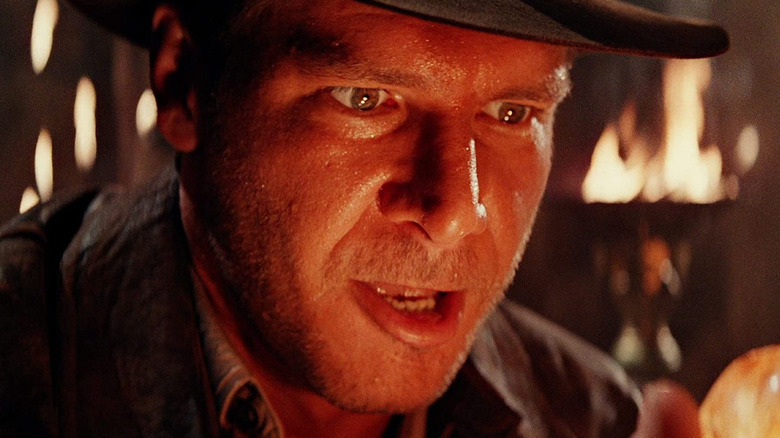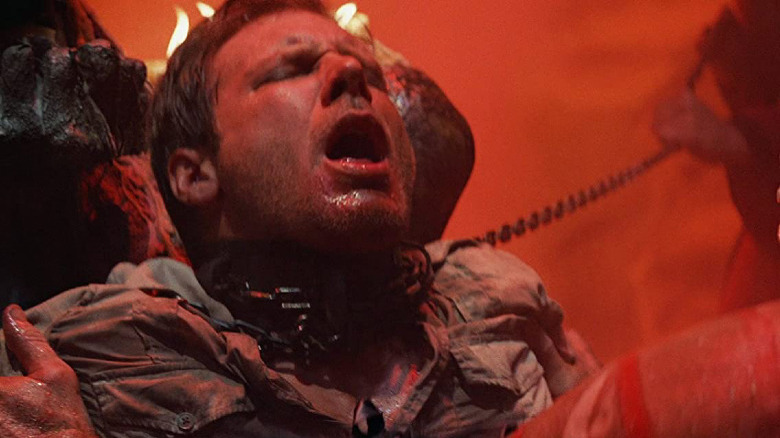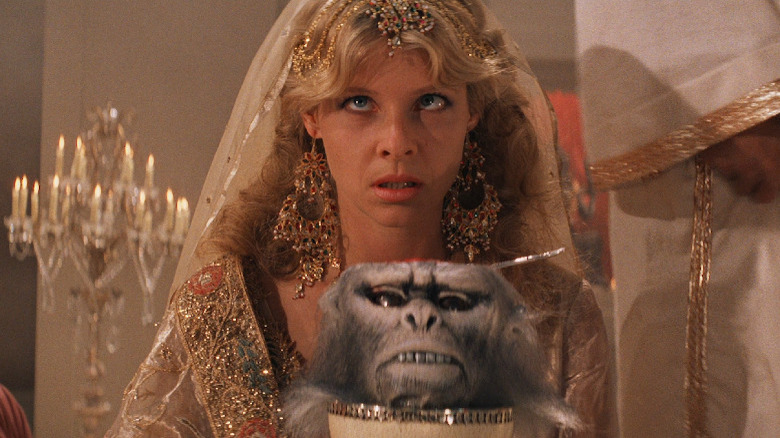Steven Spielberg Doesn't Hide Which Indiana Jones Film He Likes The Least
1984's "Indiana Jones and the Temple of Doom" is an important entry in Steven Spielberg's career as a director. It opens with a razzle-dazzle song-and-dance number in a 1930s nightclub, a marvelous sequence that spoke to the filmmaker's ability to make a killer movie musical decades before he finally realized that promise with 2021's "West Side Story." The film then proceeds to deliver one rollicking action scene after another (thrilling chases, brutal fistfights, you name it), many of which rank among the best of Spielberg's career to this day. What makes it all the more impressive is how different the movie is from Indy's first outing, "Raiders of the Lost Ark," when it comes to everything from the tone to its pulpy B-movie inspirations, all of which forced Spielberg to really challenge himself as a storyteller.
Yet, as you've no doubt already put together based on the above image and this article's headline, "Temple of Doom" remains the Indiana Jones movie Spielberg likes the least. This hasn't changed in the wake of 2008's not-so-beloved "Indiana Jones and the Kingdom of the Crystal Skull," either, as Susan Lacy confirmed back when she was promoting her 2017 documentary "Spielberg." Let's examine why that is, shall we?
'It was too dark, too subterranean, and much too horrific'
It's saying something that "Indiana Jones and the Temple of Doom" is commonly known as the "dark" Indiana Jones movie, given the many gruesome ways characters kick the bucket in the franchises's other entries. That said, "Temple of Doom" was one of the films that led directly to the PG-13 rating, and for valid reason. It's a movie where, among other things, a still-living person gets their heart ripped out of their chest before being dropped into a fiery pit, the villains enslave children to do their evil bidding, and even Indy is subjected to torture by way of voodoo dolls and being forced to drink mind-controlling "blood."
Speaking to the Sun-Sentinel in 1989, Spielberg explained that he felt "Temple of Doom" was simply too bleak for its own good. More than that, he argued it veered further into pure horror than "Poltergeist," the now-classic thriller that he co-wrote and produced (and, as the old urban legend alleges, may've secretly directed) two years before making it:
"I wasn't happy with the second [Indiana Jones] film at all. It was too dark, too subterranean, and much too horrific. I thought it out-poltered 'Poltergeist.' There's not an ounce of my own personal feeling in 'Temple of Doom.'"
George Lucas, who co-wrote and produced "Temple of Doom," was gentler to the film when interviewed by Grantland in 2012. "Oh, I'm not renouncing it," Lucas clarified. He went on to explain why the movie ended up as dark as it is:
"I was going through a divorce, and I was in a really bad mood [when I wrote the story for 'Temple of Doom']. So I really wanted to do dark. And Steve then broke up with his girlfriend, and so he was sort of into it, too. That's where we were at that point in time."
As Grantland noted in its article, Lucas' revelation certainly lends a whole deeper layer of meaning to the image of a person getting their heart (literally) ripped out in the film.
Yes, we're going to talk about the elephant in the room
To address the elephant in the room (but not the one Harrison Ford was riding when he re-injured his back): Yes, "Temple of Doom" comes across as pretty brazenly racist, even for an Indiana Jones movie. From its portrayal of the Shanghai crime bosses in its opening to the Kali-worshipping Thuggees, the film has long been criticized for perpetuating racial and ethnic stereotypes with its villains. Even with the addition of Ke Huy Quan as Indy's lovable sidekick Short Round, it's nay-impossible to overlook these elements. That's to say nothing of the choice to have "Raiders of the Lost Ark" actor Pat Roach play a Thuggee enforcer in brown-face makeup, or the way Indy is propped up as a white savior.
According to British-Indian actor Roshan Seth, who plays Chattar Lal, the film's most cringe-worthy scene — the banquet at Pankot Palace — was actually a gag that didn't land. Here's what he told Empire in 2012:
"The banquet scene was a joke that went wrong. I got a great deal of flak for it because people kept saying, 'How does an intelligent man like you agree to be in a film which shows Indians dining on beetles and eels?' Steven intended it as a joke, the joke being that Indians were so f***ing smart that they knew all Westerners think that Indians eat cockroaches, so they served them what they expected. The joke was too subtle for that film."
While the banquet scene still sounds like a bad idea (even knowing this), it does speak to the large issue of Spielberg not having a firm grasp on the tone he was going for in "Temple of Doom." As part of the same Empire article, the director suggested that it was "ahead of its time for my own sensibility and exactly right on schedule" for Lucas, himself no stranger to dark sequels after "Star Wars: The Empire Strikes Back." This also explains why he remains so hard on the movie. When push comes to shove, he feels it could've turned out better than it did, had it come later in his career.
Spielberg added:
"I'm certainly there now in my filmmaking, as you've probably witnessed ever since 'Schindler's List.' Before that, it was a bit of a struggle against common sense to go as dark as we did."


